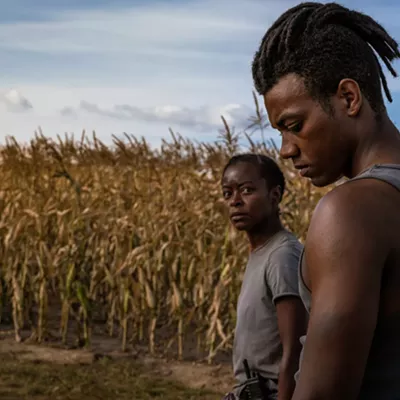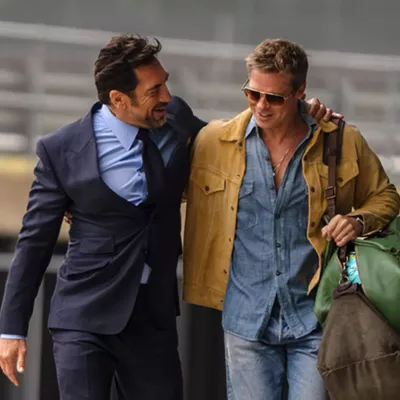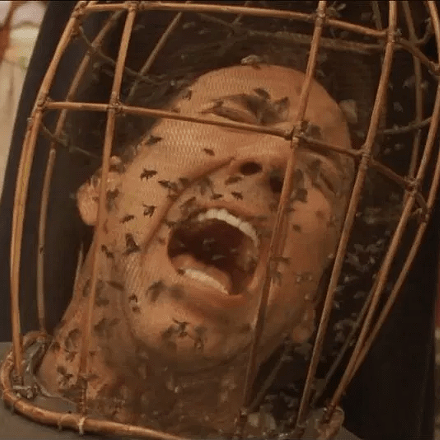Ti West's In a Valley of Violence is a film whose appeal slowly unfurls itself. Its somewhat corny pre-credits sequence, in which wanderer Paul (Ethan Hawke) has an encounter with a preacher that culminates in an attack by Paul's trusty canine companion, sees its jarring ridiculousness tempered by the purposefully hokey, stylized opening title sequence that immediately follows it.
It's this sort of compounding of "Did that really just happen?" and "Did she really just say that?" moments with corresponding contextual follow-ups that ensures the film's considerable overall effectiveness. There are more than a handful of imperfections, but they're hiccups rather than roadblocks — some on-the-nose dialogue here, an overly nature-doc-y wilderness shot there — in what turns out to be a highly entertaining new-age Western.
The film's narrative concerns the aforementioned Paul's interactions with the few denizens of poverty-stricken frontier town Denton, a place the protagonist, with his dog and horse companions, stumbles upon on his way to Mexico. Paul's scuffle with a local hothead named Gilly Martin (James Ransone) results in a series of escalating overreactions which build to outright, brutal violence.
Caught in the crossfire is Gilly's father, who happens to be Denton's morally righteous marshal. He's played by John Travolta, with hairstyling and costuming that, when paired with the actor's low-key performance, sometimes allows Travolta to escape his megastar persona. The marshal is the only character in the film who's truly and consistently reasonable, and his presence (and ultimate fate) strengthens the film's critique of brash, senseless violence.
There's an accompanying religious element at play in Valley's overarching message, highlighted by Burn Gorman's memorable turn as a shady preacher in the scenes that bookend the film, though this aspect isn't terribly well fleshed-out.
It's an example, however, of one of the numerous, notable sub-arcs that grace Valley's supporting cast. Some are simply amusing, while others carry moral implications of their own. Take, for instance, Gilly's crony Harris, who pointedly hesitates at one point before committing an act of violence and is later given a chance to redeem himself — only to hesitate at the second opportunity as well. Like many of the sub-arcs, it's not innately connected to the central narrative. The holistic effect of these stories is to add an unusual degree of depth and character to the world inhabited by Valley's ensemble.
Prominent in the main plot is the role of Mary Anne, the young proprietor of Denton's inn. Taissa Farmiga's performance in this role is unconvincing in intervals, but she evokes smiles whenever she engages in sibling banter with her sister or launches into a giddy monologue of excitement. Mary Anne's immediate fascination with Paul serves as the main catalyst for the unearthing of his shadowy background. This narrative component is kept surprisingly out of the spotlight in an era where the protagonist with the mysterious, twisty-turvy past is a predominant cinematic recurrence. It serves more as a backdrop for the present events than as a driving force of the plot, and adds an extra layer to the film's moral ambiguity.
The dialogue by writer/director Ti West plays at times like a highlight reel of wonderfully hyperbolic Western tropes, whether it be the troublemaker's overblown calls for a testosterone-driven duel with his adversary or Paul's hilariously delivered (courtesy of Hawke), repeated response of "no" to a quick series of questions from Mary Anne, likely a nod to the "mysterious stranger" archetype that so often inhabits Westerns.
These sorts of tidbits place In a Valley of Violence somewhere in between a full-blown genre satire and an ode to Westerns of yesteryear, driven by adherence to (and effective execution of) genre conventions. It may not fit comfortably into classifications or always fire on all fronts, but it handily manages to be equal parts hilarious, engaging and thematically resonant. ♦


















